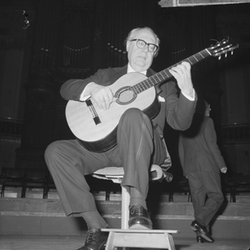Important Figures of the Classical Guitar
The following list contains many important figures of the classical guitar, including composers, performers, and builders. It is not exhaustive by any means, but hopefully will provide you with a good start.
Antonio de Torres Jurado
Torres is generally credited with
establishing the standards regarding modern classical guitar
construction. By increasing the overall size and focusing on the
projecting qualities of the soundboard, Torres made the classical guitar
a viable solo and concert instrument. His system of fan bracing also
increased the guitar's durability and allowed for lighter soundboards,
improving the instrument's tone. His contributions to classical guitar construction easily make him one of the most important figures of the classical guitar.
Fernando Sor
Himself a
celebrated guitarist and virtuoso, Fernando Sor has perhaps contributed
more to the respect of the guitar as a viable instrument for serious
composition than any other composer to date. Although he composed music
for other instruments as well as for voice, his numerous classical
guitar compositions have secured his fame for posterity. Sor also wrote a
celebrated and comprehensive method for studying guitar.
Heitor Villa-Lobos
A
self-trained guitarist as well as cellist and violaist, Brazilian
Villa-Lobos's compositions are noted for their fusion of popular folk
music of his home country with traditional classical music. Noted
classical guitarist Andrés Segovia commissioned Villa-Lobos to write a
study for him. The result was a series of 12 etudes which are still
considered necessary repertoire for any serious classical guitarist.
Andrés Segovia
If
any name has become synonymous with classical guitar, it is Andrés
Segovia. A self-taught guitarist who initially began as a violinist,
Segovia has a well-earned reputation as a true maestro. Known for his
rigorous demands from both his students and himself, Segovia's
self-developed technique actually expanded his grasp of the instrument
rather than hindering it and showed his critics (including his parents)
what range the guitar was capable of as a solo instrument. A noted
transcriptionist who also commissioned several works, Segovia performed
professionally for several decades until his death in 1987, leaving behind a legacy that easily made him one of the most important figures of the classical guitar.
Julian Bream
Born
to a musical family, specifically a father who played jazz guitar,
Julian Bream displayed prodigious talent from an early age and was
admitted to the Royal College of Music to study piano and cello, though
he had already started giving formal concerts as a guitarist. Known for a
wide range of styles and influences, Bream is also a noted lutenist who
has contributed much to that instrument's recent resurgence. His
eclectic repertoire and technical mastery make him one of the most
renowned guitarists since Segovia.
John Williams
Lauded by
some as the most technically proficient guitarist in recent memory, John
Williams was taught initially by his father, himself a talented
guitarist. He eventually impressed noted guitarist Andrés Segovia, who
took Williams on as a pupil for several years (though Williams would
eventually come to question Segovia's teaching methods). In addition to
his excellent technique, Williams is a noted ensemble player who is also
unafraid to embrace more popular forms of music, even collaborating
with The Who's Pete Townsend on occasion.
Eliot Fisk
One of
Andrés Segovia's most celebrated students, Eliot Fisk is noted not only
for his technical prowess and wide range of repertoire, but is
particularly passionate about teaching and making "art" music more
accessible to the masses. Although he is no stranger to the concert
hall, he also performs in arenas such as schools and retirement homes,
even prisons on occasion. A graduate of Yale University, Fisk was the
founder of the school's guitar program and the last direct pupil of
Segovia.
Christopher Parkening
A recognized prodigy who entered the University of Southern California originally to study cello since the school had no guitar department, he was asked as a sophomore to begin the department. Recognized by Segovia as one of the finest guitarists in the world and proud to continue in the tradition of his mentor, Parkening eventually would retire from playing to retire in relative seclusion. However, a conversion to Christianity inspired him to once again perform regularly, offering his playing to God rather than focusing upon his own accomplishments.
Important Figures of the Classical Guitar - Final Words
I admit - the above list is subjective. But I'd love to hear from you! If there are any names you'd like added to this list, send me a message and let me know what you think.
Add Your Comments Here!
I'd love for you to be a contributor to SoMuchGuitar.com!
Just fill out the information below to add to this page. I'll be in touch about your submission soon!
